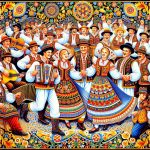
The Polish rock music scene stands out globally, thanks to its deep history and dynamic development. In the 1980s, rock music in Poland was known for its political messages, giving a voice to people craving freedom.
Today, Polish rock musicians mix traditional elements with modern rock, showing off Poland’s wide-ranging musical talents. These musicians have not only played a big part in shaping Poland’s musical identity but have also caught the eye of international audiences, affecting the rock genre well beyond Poland.
When we look at the important albums and famous live music spots that have marked this scene, we have to wonder: what’s next for Polish rock music?
Historical Overview
Polish rock music has been a vibrant part of the country’s culture since the late 1950s. It started as a way for young people to push back against the Communist regime’s tight control over artistic expression. Rock music offered a voice to those who felt silenced and brought together a community of like-minded individuals. The 1980s were especially crucial for Poland, with the emergence of the Solidarity movement challenging the status quo. During this time, rock music became more than entertainment; it turned into a powerful tool for political and social activism, echoing the public’s demand for freedom and democracy.
As Poland moved away from its Communist past, the rock scene evolved, absorbing various musical styles and influences. This period of transformation allowed the genre to stay relevant and continue to resonate with both old and new audiences. Bands and artists experimented with different sounds, blending rock with other genres and thereby enriching the Polish music landscape.
For example, the band Maanam, which emerged in the late 1970s, became iconic in the 1980s not just for its unique sound but also for its lyrics that subtly criticized the political system, resonating with the widespread desire for change. In the post-Communist era, newer bands like Myslovitz gained popularity by mixing rock with elements of Britpop and alternative rock, reflecting the country’s ongoing cultural openness and integration with global trends.
Today, the Polish rock scene is a testament to the country’s resilience and adaptability. It shows how music can both reflect and influence societal changes, serving as a mirror to Poland’s journey toward modernization and cultural diversity. Whether you’re a long-time fan or new to the genre, exploring the rich tapestry of Polish rock music offers a unique insight into the nation’s soul, marked by its struggle for freedom, its embrace of change, and its unwavering spirit.
Key Bands and Artists
Exploring Poland’s rock scene reveals a vibrant history, marked by bands and artists who significantly influenced its development and cultural impact. Among these, Maanam stands out for its unique approach to rock music. Led by the charismatic Kora, Maanam mixed rock with elements of new wave and punk, creating a sound that was both innovative and captivating. Their music wasn’t just about catchy tunes; it was a bold artistic statement that set new standards for creativity in Polish rock.
On the other hand, Dżem offered a different flavor with their blues-rock style. Their music, rich in emotional depth and complexity, attracted listeners looking for something more soulful and profound. Dżem’s ability to convey powerful emotions through their music made them a beloved figure in Poland’s rock narrative.
These artists did more than just shape the sound of their time; they laid the groundwork for future musicians. Their legacy is evident in the diversity and innovation that continue to define Polish rock music. For anyone looking to dive deeper into this genre, exploring the discographies of Maanam and Dżem is a great starting point. Their music not only provides a glimpse into the evolution of Polish rock but also offers timeless tracks that remain influential and relevant today.
Influential Albums
When we dive into the music history of Poland, especially the rock genre, we can’t overlook the significant impact of albums like ‘Nocny Patrol’ by Maanam from 1983 and ‘Cegła’ by Dżem released in 1985. These albums are crucial in understanding how Polish rock music developed. ‘Nocny Patrol’ and ‘Cegła’ stand out because they creatively blend rock music with the unique aspect of Polish poetry. This mix brought a new level of depth to the lyrics and the music itself.
Moreover, Jacek Kaczmarski’s ‘Mury’, though it leans more towards folk music, played a monumental role in Poland’s history. It became an anthem for the Solidarity movement, demonstrating how powerful music can be in driving socio-political change. This song is a perfect example of how artists like Kaczmarski used their music to reflect and influence the world around them.
These albums did more than just mark milestones in their creators’ careers; they shaped the cultural identity of Poland. They showed that music could be a tool for reflection, revolution, and expression, intertwining with the country’s political and social fabric. Albums like ‘Nocny Patrol’, ‘Cegła’, and songs like ‘Mury’ remind us of the transformative power of music. They serve as a testament to the creativity and resilience of Polish artists, inspiring new generations to explore and push boundaries in their own creative pursuits.
Live Music Venues
Live music venues across Poland have been crucial in the development and popularity of rock music. These places, which vary in size from small clubs to large concert halls, have provided a stage for artists to connect with their fans and display their skills. They have been essential in nurturing new talent and keeping the Polish rock music scene vibrant and dynamic. By hosting a wide range of live performances, these venues have attracted a diverse audience and given artists the chance to refine their musical style. More than just places for concerts, these venues are important cultural sites that reflect the history and ongoing changes in Polish rock music, showing its enduring spirit.
For example, clubs like Klub Stodoła in Warsaw and Kraków’s Klub Studio have become legendary for their role in the Polish music scene. They have hosted countless performances by both up-and-coming and established artists, providing a crucial stepping stone for many musicians’ careers. The impact of these venues goes beyond music; they contribute to the cultural fabric of their cities, bringing people together and fostering a sense of community around live music.
The importance of live music venues in Poland also lies in their ability to adapt and respond to the evolving tastes of audiences and the creative needs of artists. This flexibility has allowed the rock music scene in Poland to thrive, continuously introducing fresh sounds and innovative performances. It’s not just about preserving the past; these venues are actively shaping the future of Polish rock music by encouraging experimentation and supporting the artistic journey of musicians.
Future of Polish Rock
The future of Polish rock music looks bright, thanks to the strong foundation of live music venues across the country. This musical genre, which holds a special place in the heart of Polish culture, is going through a revival. This new wave is a mix of old-school vibes and modern trends. Today, upcoming bands and solo artists are using online platforms to reach more fans. This strategy is helping them move from the underground scene to mainstream success more smoothly.
One of the exciting developments in Polish rock is how artists are mixing in electronic sounds and working with musicians from other genres. This approach is making Polish rock more dynamic and breaking it out of its traditional mold. Plus, there’s a growing interest in Polish music from outside the country, which could help these artists become internationally known. As these trends keep up, Polish rock is on its way to carving out a new identity for itself, making sure it stays relevant and lively on the world stage.
For example, the band Riverside is blending progressive rock with electronic elements, creating a unique sound that’s gaining attention both in Poland and abroad. Another example is Dawid Podsiadło, who combines pop with rock influences, appealing to a wide audience and showcasing the versatility within the Polish rock scene.
Conclusion
The Polish rock music scene is really interesting. It’s full of history, a mix of different music styles, and has a great atmosphere for live concerts.
Some really important bands and artists have helped make it what it is today, and there are albums that have made a big impact both in Poland and around the world.
With places for live music helping to bring people together and push for new ideas, it looks like Polish rock music has a bright future ahead. It could even become more popular worldwide.






Comments are closed.